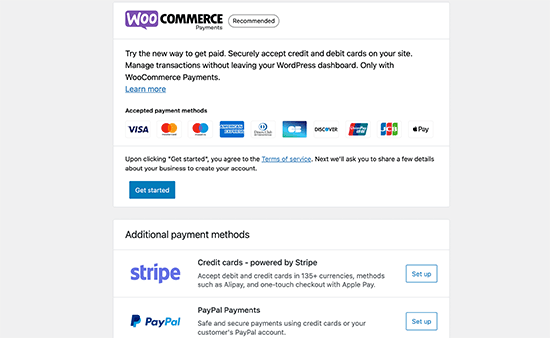Shopify and Woocommerce are two of the most popular platforms available to create an online store. Which one should you choose? Here, we’ll take a close look at how they stack up against each other, and hopefully provide you with enough information to help you make your decision.
Related: How to start an online store with WooCommerce
WooCommerce Pros
Considered one of the best free ecommerce platforms available, WooCommerce lets you start and run a successful online shop without any programming knowledge. It’s relatively simple to set up, but is also capable of managing much more complex stores as your business grows.
The plugin also features some advanced capabilities like multi-language support and large store catalogs – perfect for those who want their shop to go global right out of the gate. Considering its low cost, open source nature, and impressive functionalities, there is no wonder why Woocommerce is still so popular among ecommerce developers all over.
Bottom line: excellent shopping cart solution if you are on a budget but don’t want to sacrifice flexibility or time-to-market.
WooCommerce Cons
If you’re looking for an online platform for creating a simple online store with minimal custom development, WooCommerce may not be right for you. It offers only a few customization options and can’t support every feature your business might need.
It’s also free – which can come with costs when it comes to security updates, quality assurance testing, and more. Additionally, it relies on WordPress themes that weren’t built specifically for ecommerce, so there are some limitations in terms of site design and function.
Finally, WooCommerce users tend to have less technical knowledge than their Shopify counterparts (see below), so they may not be able to troubleshoot problems as easily or quickly as someone who knows their way around code.
The real cost of using Woocommerce
WooCommerce is a free e-commerce plugin which is also known as self hosted WordPress.
However, you will need a domain name which costs around $14/year and hosting which costs around $7.99/month. This is fairly expensive if you’re just running a startup
Fortunately, there are web hosting services like SiteGround who are now offering specialized WooCommerce hosting plans which reduces the cost
The real cost of using Shopify

Although Shopify makes it really easy to start your online store, the basic plan of them starts at $29 per month.
However, you can upgrade to the Shopify plan for $79/month or the Advanced Shopify plan for $299 per month.
All of these plans includes SSL certificate and web hosting. It will come with a Shopify branded subdomain (e.g. https://your-store.myshopify.com).
If you wish to have your own domain, the cost of a (.com) domain generally starts from $14/year.
Payments are another factor that affects your costs. Shopify offers their own Shopify Payments result which costs 2.9% + 30 cents per sale for the basic plan.
Still, also you’ll be charged a flat fee of 2, If you want to use third- party payment gateways or your own merchant account 2.0% for all transactions. You can reduce this figure to 0.5% by using the Shopify Advanced plan which costs $299 per month.
Shopify additionally gives a plan known as Shopify lite which costs $9.00 / month. This plan helps you to upload purchase buttons to any site or use Shopify for in-person sales in select regions.
For instance, you may create a WordPress internet site and upload Shopify purchase buttons there. However, in case you are already creating a WordPress internet site, then the usage of WooCommerce might allow you to provide a far higher experience.
Payment Gateways for WooCommerce
Paypal and Stripe are default payment methods of WooCommerce. A WooCommerce Payments solution is also available which is powered by Stripe.

For fee gateways, WooCommerce even has help for lots regional and much less famous payment services. Since there may be no barrier to entry, any payments organization can create plugins for WooCommerce and offer assistance for it.
WooCommerce never charges a transaction fee on a payment unless you’re using WooCommerce Payments Solution. You are only charged by a third-party gateway that you’re using (eg. your bank)
you will save A TON of money by using WooCommerce. If choosing your own merchant account and using a third-party payment gateway is important for you.
Payment Gateways for Shopify
Shopify gives lots of payment alternatives that customers can use in the course of checkout. It has its very own payments solution known as Shopify Payments (powered by Stripe) in addition to popular third-party payment gateways.

The trouble is that Shopify fees an additional 2% fees on every transaction made via third party payment gateways. This is on top of the transaction costs charged by the payment gateway. You can lessen the rate to 0.5% by paying $299 per month for Advanced Shopify plan.
Shopify Payments has no transaction fees but has a credit card fees, Credit card rates start from 2.9% + 30¢ for the basic plan and get lower for other plans.
Shopify Pros
The basic Shopify plan comes with enough features to set up a new online store. You can add unlimited products, 2 user accounts, infinite file storage, and more.
Both of these platforms have a lot to offer, but when it comes down to it, Shopify has a few major advantages over Woocommerce that set it apart. The first is its flexibility. While WooCommerce is an amazing platform and can certainly get you where you need to go in terms of ecommerce functionality, its interface isn’t all that easy to customize if you have more advanced needs.
In comparison, Shopify’s versatility gives developers complete control over how their store looks and functions from day one, which is a huge selling point for anyone who’s looking for long-term success online.
Shopify Cons
While it’s great for building an online store, Shopify does have a few disadvantages. Most notably, it can be very difficult to build an app or extension that integrates with your store–even though you are technically allowed to do so by their Terms of Service.
It’s easier if you hire an expert, but expect to pay a hefty premium. Most of the plugins are pricey with either one-time payment or a monthly recurring one. On top of that, there is almost no community around Shopify–if you can’t find what you’re looking for on their forums or elsewhere on Google/YouTube, good luck figuring it out yourself!
When to use Woocommerce over Shopify
If you’re not into technical stuff or just starting on a budget, Woocommerce could be a great option for you unlike Shopify’s high prices. However, it might not be a good option for you if you’re starting a dropshipping business from Amazon.
Because they don’t allow the use of third-party apps. Woocommerce is great if you’re setting up an online shop with multiple products, but aren’t sure if it’s worth it to make your own ecommerce store. It’s free, easy to use and easy to install (it’ll take only a few minutes.) But don’t let that fool you – Woocommerce offers plenty of advanced options for people who have a bit more technical skill.
If you’re trying to build an online store, and are worried about building out a full-fledged ecommerce platform from scratch; or maybe want to get started without spending too much money, woocommerce is probably your best bet.
When to use Shopify over Woocommerce
The features offered on a Woocommerce site are more of a middle ground. If you’re an ecommerce store owner, you probably don’t need most of what Woocommerce has to offer.
That said, it does have its own strengths over shopify and may be better for certain business owners. For example, while Shopify can handle multiple stores with ease, Woocommerce is geared toward one-off stores.
So if you are looking for something simpler yet advanced, go for shopify. If you are into Amazon dropshipping, then shopify might be your best bet!
Conclusion
As you can see, both are excellent ecommerce platforms. However, if you’re looking for a platform that’s flexible and easy to use, Woocommerce is a great choice.
If you want your business on mobile and want to easily get your online shop in front of thousands of users per month, Shopify might be a better choice. It all depends on what your needs are as an entrepreneur.
Whichever platform you decide to go with, make sure it integrates seamlessly with other software like Stripe for payment processing or Mailchimp for email marketing. Both have affordable plans that allow you to grow without breaking your budget.






